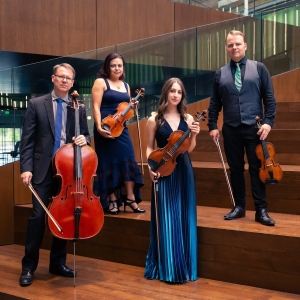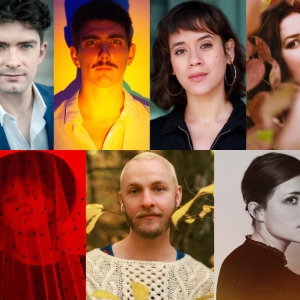
At a Glance
Time Needed: 90 min.
Ages: All
Allows Food/Drink: No
Luggage Storage: No
150 W 17th St, New York, NY 10011 Get Directions
The Rubin Museum of Art Videos
Khadhok – Tibetan Artists’ Collective provides a dedicated space for Tibetan contemporary visual artists to present their work, exchange ideas, and strengthen their practice, with a focus on emerging artists. Since its founding in 2023, Khadhok has grown into a vibrant platform for artistic exchange, community engagement, and youth empowerment. For the founders, winning the 2025 Rubin Museum Himalayan Art Prize “strengthens our confidence and encourages us to keep growing. Most importantly, it changes what is possible for Khadhok, allowing us to build a strong foundation that truly lasts and supports artists and our community for many years to come.” The Rubin Museum Himalayan Art Prize was established to support living artists and recognize the work of innovative individuals who have made a mark in creative and critically relevant dialogues between Himalayan art and contemporary life. About the Rubin Museum of Himalayan Art The Rubin is a global museum dedicated to presenting Himalayan art and its insights through exhibitions, participatory experiences, a dynamic digital platform, and partnerships. Inspired and informed by Himalayan art, the Rubin invites people to contemplate the human experience and deepen connections with the world around them in order to expand awareness, enhance well-being, and cultivate compassion. rubinmuseum.org Subscribe to the Rubin Museum YouTube channel: https://www.youtube.com/@RubinMuseum Instagram: https://instagram.com/rubinmuseum Facebook: https://www.facebook.com/rubinmuseum Newsletter: https://rubinmuseum.org/newsletter
The Rubin Museum of Himalayan Art presents a weekly meditation for beginners and skilled meditators alike. Each episode is inspired by a different work of art from the Museum’s collection and is led by a prominent meditation teacher. The episode begins with an opening talk followed by a 20-minute meditation. In this episode, the guided meditation begins at 10:31. Teacher: Elaine Retholtz Theme: Wisdom Page of the Perfection of Wisdom (Prajnaparamita) Sutra Manuscript ( https://rubinmuseum.org/collection/c2006-66-669/ ); Tibet; ca. 13th–14th century; pigments, gold and silver inks on paper; Rubin Museum of Himalayan Art; C2006.66.669 Learn more about the Rubin’s work around the world at rubinmuseum.org ( http://rubinmuseum.org ). Mindfulness Meditation Podcast Episode 505 December 12, 2025 ★ Additional episodes: https://rubinmuseum.org
The Rubin Museum of Himalayan Art presents a weekly meditation for beginners and skilled meditators alike. Each episode is inspired by a different work of art from the Museum’s collection and is led by a prominent meditation teacher. The episode begins with an opening talk followed by a 20-minute meditation. In this episode, the guided meditation begins at 13:55. Teacher: Lavina ShamdasaniTheme: Generosity Vasudhara, Goddess of Abundance ( https://rubinmuseum.org/collection/c2007-27-2/ ); Nepal; 17th century; gilt copper alloy; Rubin Museum of Himalayan Art; C2007.27.2 Learn more about the Rubin’s work around the world at rubinmuseum.org ( http://rubinmuseum.org ). Mindfulness Meditation Podcast Episode 504 December 5, 2025 ★ Episode details: https://share.transistor.fm/s/36e51093 ★ Additional episodes: https://rubinmuseum.org
The Rubin Museum of Himalayan Art presents a weekly meditation for beginners and skilled meditators alike. Each episode is inspired by a different work of art from the Museum’s collection and is led by a prominent meditation teacher. The episode begins with an opening talk followed by a 20-minute meditation. In this episode, the guided meditation begins at 18:39. Teacher: Michel Pascal Theme: Generosity Mandala Offering Set ( https://rubinmuseum.org/collection/sc2012-7-1a-e/?_gl=1*1s1wusn*_up*MQ..*_gs*MQ..&gclid=CjwKCAiAuIDJBhBoEiwAxhgyFnsewFjMMOdGx6KUeiJYmm7YbBrjQ2TPHrs3Cl_jeiIKjVwZvdgB0RoCQ5EQAvD_BwE&gbraid=0AAAAADim4xnU2VezyJw8uQLtGgrEQ417V ); Central Tibet; mid 20th century; gilt silver; Rubin Museum of Himalayan Art; gift of Shelley and Donald Rubin; SC2012.7.1a-e Learn more about the Rubin’s work around the world at rubinmuseum.org ( http://rubinmuseum.org ). Mindfulness Meditation Podcast Episode 503 November 28, 2025 ★ Episode details: https://share.transistor.fm/s/546bcf19 ★ Additional episodes: https://rubinmuseum.org
The Derge Parkhang, or Derge Printing House, was founded in 1729 in the Kham region of eastern Tibet by the local king Tenpa Tsering (1678–1738). It continues to produce texts and images today using traditional woodblock printing methods. This film, which was created as part of the Derge Parkhang—Wesleyan University Collaborative Research Project (2006–2009), records the process of woodblock printing: from mashing insect-resistant plant roots into paper pulp, paper making, cutting texts into wooden blocks, editing and correcting, printing and finishing, and selling at the local shop. About the Rubin Museum of Himalayan Art The Rubin is a global museum dedicated to presenting Himalayan art and its insights through exhibitions, participatory experiences, a dynamic digital platform, and partnerships. Inspired and informed by Himalayan art, the Rubin invites people to contemplate the human experience and deepen connections with the world around them in order to expand awareness, enhance well-being, and cultivate compassion. rubinmuseum.org Subscribe to the Rubin Museum YouTube channel: https://www.youtube.com/@RubinMuseum Instagram: https://instagram.com/rubinmuseum Facebook: https://www.facebook.com/rubinmuseum Newsletter: https://rubinmuseum.org/newsletter
The Rubin Museum of Himalayan Art presents a weekly meditation for beginners and skilled meditators alike. Each episode is inspired by a different work of art from the Museum’s collection and is led by a prominent meditation teacher. The episode begins with an opening talk followed by a 20-minute meditation. In this episode, the guided meditation begins at 09:23. Teacher: Dr. Chok Tenzin Monlam Theme: Generosity Buddha Ratnasambhava with Wealth Deities ( https://rubinmuseum.org/collection/c2005-16-39/?_gl=1*q701ex*_up*MQ..*_gs*MQ..&gclid=Cj0KCQiArOvIBhDLARIsAPwJXOY0OBP59G1NS121u-fTInNZJt2dPfxVcYhKBOON1r0axDj7Pe0pyhoaAkmZEALw_wcB ); Tibet; early to mid-14th century; mineral pigments on cloth; Rubin Museum of Himalayan Art; C2005.16.39 Learn more about the Rubin’s work around the world at rubinmuseum.org ( http://rubinmuseum.org ). Mindfulness Meditation Podcast Episode 502 November 21, 2025 ★ Episode details: https://share.transistor.fm/s/d83d5405 ★ Additional episodes: https://rubinmuseum.org
More in Chelsea
More Museums
- The Tenement Museum
- New Museum
- International Center of Photography
- Museum at Eldridge Street
- National Museum of the American Indian
- National September 11 Memorial & Museum
- Whitney Museum of American Art
- The Morgan Library & Museum
- Museum of Modern Art (MoMA)
- Museum of Arts and Design
The Rubin Museum of Art Frequently Asked Questions
The closest subway stops to The Rubin Museum of Art at 150 W 17th St in New York City are:
1. 14th Street Station: This station is served by the 1, 2, 3, F, M, L, and PATH trains. It's just a short walk from the museum.
2. 18th Street Station: This station is served by the 1 train and is also within walking distance to the museum.
I recommend checking the MTA website for the most up-to-date subway schedules and service changes. You can visit their website at https://new.mta.info/.
While you're in the area, I also suggest exploring the vibrant neighborhood of Chelsea. It's known for its art galleries, trendy shops, and delicious dining options. The High Line, an elevated park built on a historic freight rail line, is a must-visit attraction nearby. You can take a leisurely stroll along this unique park and enjoy stunning views of the city.
If you're in the mood for some shopping, head over to the nearby Meatpacking District, where you'll find a mix of high-end boutiques and popular brands.
I hope you have a fantastic time exploring the area and enjoy your visit to The Rubin Museum of Art!
The closest bus stops to The Rubin Museum of Art at 150 W 17th St in New York City are:
1. 7th Ave/W 17 St - served by the M7 and M20 buses. You can find the latest updates on these bus routes on the MTA website.
2. 6th Ave/W 18 St - served by the M5, M7, M55, and X1 buses. You can check for any changes or delays on these bus routes on the MTA website.
Remember to check the MTA website or use a reliable transit app for real-time updates on bus schedules and any service changes. Enjoy your visit to The Rubin Museum of Art!
The ideal length of time to plan for a visit to The Rubin Museum of Art in New York City depends on your level of interest in Himalayan art and culture. On average, visitors spend about 1 to 2 hours exploring the museum's galleries and exhibitions. However, if you have a deep passion for this subject or wish to engage in the museum's interactive programs, you may want to allocate more time.
The Rubin Museum offers a diverse range of exhibits, including ancient sculptures, paintings, and contemporary art from the Himalayan region. It also hosts regular events, such as film screenings, performances, and talks, which can enhance your experience. If you plan to attend any of these events, it's a good idea to check the museum's website for the schedule and plan accordingly.
Additionally, the museum has a café and a gift shop where you can relax, grab a bite to eat, or browse through unique items inspired by Himalayan art. So, if you want to fully immerse yourself in the museum's offerings, consider setting aside some extra time for these activities as well.
Overall, whether you have a few hours or an entire day, The Rubin Museum of Art is a captivating destination that offers a rich cultural experience.
The Rubin Museum of Art in New York City has a café called Café Serai that offers a variety of food and drink options. Visitors are welcome to enjoy their meals and beverages in the café, which features a relaxed and comfortable atmosphere. However, please note that outside food and drink are not permitted in the museum galleries. So, if you're planning to explore the museum, you'll need to finish your snacks or beverages before entering the exhibition spaces.
The Rubin Museum of Art in New York City does not have a dedicated luggage storage facility. However, they do allow small bags and backpacks into the museum. If you have larger bags or suitcases, it is recommended to check with nearby hotels or other luggage storage services in the area. There are several options available, such as luggage storage facilities, lockers, or even some hotels that offer luggage storage for non-guests. It's always a good idea to plan ahead and make arrangements for storing your luggage while visiting the museum or any other attractions in the city.
Yes, The Rubin Museum of Art is a fantastic destination for visitors from other countries and non-English language speakers. The museum showcases an extensive collection of art from the Himalayas and surrounding regions, offering a unique cultural experience that transcends language barriers.
While the museum provides English-language information and labels, they also offer audio guides in multiple languages, including Spanish, French, German, Mandarin, and Japanese. These guides provide detailed explanations of the artworks, ensuring that visitors can fully appreciate the exhibits regardless of their language proficiency.
Additionally, The Rubin Museum of Art frequently hosts special events, performances, and workshops that delve into the rich cultural heritage of the Himalayan region. These events often feature live music, dance, and storytelling, providing an immersive experience that appeals to all visitors, regardless of their language background.
Overall, The Rubin Museum of Art is a must-visit for anyone interested in exploring the art and culture of the Himalayas, and its language-friendly offerings make it a welcoming destination for visitors from around the world.
The Rubin Museum of Art in New York City is a wonderful destination for visitors of all ages. While there is no specific age range recommendation, the museum offers a range of exhibits and programs that can be enjoyed by both children and adults. The museum's collection primarily focuses on Himalayan art, including paintings, sculptures, and textiles, which can be fascinating for art enthusiasts of all ages. Additionally, the museum often hosts interactive workshops, family programs, and storytelling sessions that are designed to engage younger visitors. So whether you're traveling with kids or exploring the city on your own, be sure to include a visit to The Rubin Museum of Art on your itinerary!
Videos
















